.
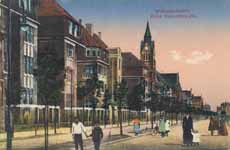
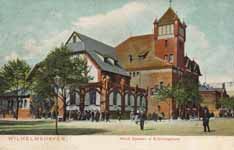
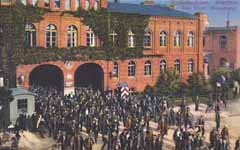
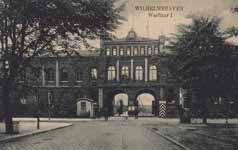
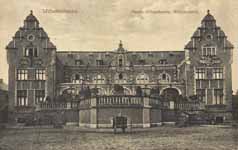
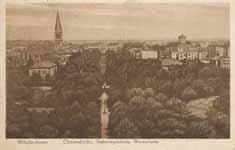
7, 8, 9, 10, 11, 12,
Wilhelmshaven
Wilhelmshaven (German pronunciation: [vɪlhɛlmsˈhaːfən]) is a coastal town in Lower Saxony, Germany. It is situated on the western side of the Jade Bight, a bay of the North Sea.
History
The Siebethsburg castle, built before 1383, was occupied by pirates and destroyed in 1433 by the Hanseatic League. Four centuries later, the Kingdom of Prussia planned a fleet and a harbour on the North Sea. In 1853, Prince Adalbert of Prussia arranged the Jade Treaty (Jade-Vertrag) with the Grand Duchy of Oldenburg, in which Prussia and the Grand Duchy entered into a contract: 3.13 km² of Oldenburgian territory at the Jade Bight should be ceded to Prussia. In 1869, King William I of Prussia (later also German Emperor) founded the town as an exclave of the Province of Hanover as a naval base for Prussia's developing fleet. All the hinterland of the city remained as part of the Duchy of Oldenburg.
A shipbuilders was established at Wilhelmshaven, the Kaiserliche Werft Wilhelmshaven (Imperial Shipyard Wilhelmshaven). On 30 June 1934, the "pocket battleship" Admiral Graf Spee was launched at Wilhelmshaven.
In 1937, Wilhelmshaven and Rüstringen merged[citation needed] and the united city, named Wilhelmshaven, became a part of the Free State of Oldenburg.
World War II
See also: Bombing of Wilhelmshaven in World War II
Two thirds of the town's buildings were destroyed during bombing by the Allies of World War II.[citation needed]. On 5 May 1945, Polish forces under General Stanisław Maczek captured Wilhelmshaven and took the surrender of the entire garrison, including some 200 ships of the Kriegsmarine. They remained as part of the allied occupation forces. During World War II Alten Banter Weg (No. 1582 Wilhelmshaven) was a subcamp of the Neuengamme concentration camp. In 1947 the city council decided to seek a new emblem for the city. After several designs were rejected by the British military government an emblem of a Frisian warrior(Rüstringer Friesen) was chosen, designed after a nail man erected in the city during the first world war to collect war donations.
Wilhelmshaven today
Wilhelmshaven and its city districts
After the war the harbour was used not only for military purposes, but for economy and tourism as well. Today, Wilhelmshaven is the German navy's main base at the North Sea again. It is also the third largest German port (after Hamburg and the combined ports of Bremen and Bremerhaven) with mainly oil products being loaded and unloaded. Besides the military, chemical industries and a refinery are the main employers of Wilhelmshaven which has one of the highest unemployment rates in the western part of Germany. The oil terminal and the refinery are connected with other German industrial centres by pipelines. Wilhelmshaven also provides an Applied Sciences University (Fachhochschule) for engineering and business sciences.
Economic hopes rest in following major development projects:
the JadeWeserPort project for a deep water container port to be constructed 2006 - 2010, able to berth even the largest container vessels presently under construction
the construction of a 800 MW power plant; completion in year 2012
the further development of the chemical industry
the construction of an LNG-Terminal
the proposed coastal highway (Küstenautobahn) connecting north-western German industrial centres at the Elbe, Weser, and Ems rivers.
Sights
Aquarium Wilhelmshaven, an aquarium with native animals from the North Sea, the information centre of the Lower Saxony Wadden Sea National Park.
The Botanischer Garten der Stadt Wilhelmshaven, a municipal botanical garden.
The Deutsches Marinemuseum (Navy Museum), whose main exhibits are the former German Navy] destroyer Mölders (D186), a submarine, and some smaller warships as well as an exhibition of German naval history from the 19th century onwards.
The Küstenmuseum (Coast Museum).
The Bontekai, city harbor jetty, featuring the former light vessel "Weser" and the steam engine powered buoy layer "Kapitän Meyer", an active museum ship. During the "Jade Weekend" (late June) it is berth of tall sailing ships, too.
As the town's landmark the Kaiser-Wilhelm-Brücke ("Emperor Wilhelm Bridge") is considered, which crosses an inlet of the Jade Bight. It was built in 1905 to 1907; with a length of 159 m it was once the greatest swing bridge of Europe.
The Town Hall (Rathaus), a large brick building, constructed in 1927-1929 by the architect Fritz Höger as the town hall of the city of Rüstringen.
The Christus-und-Garnisionskirche, the oldest church of the city. It was built in 1869 by the Prussian architect Friedrich Adler.
Kaiser-Wilhelm-Denkmal at the Friedrich-Wilhelm-Platz, a monument erected in memory of emperor Wilhelm I of Prussia in 1896, who was one of the founder of the city. After the statue had been melted down in 1942, it was reconstructed in 1994.
The entrance building of the former Kaiserliche Marinewerft ("emperor's shipyard"), built in the 1870s.
The building of the former Kaiserliche Westwerft ("emperor's western shipyard"), completed in 1913.
People
Rainer Fetting *1949, artist (modern painting)
Town twinnings
From Wikipedia, All text is available under the terms of the GNU Free Documentation License
